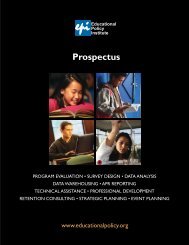A BluePrint for Success: Case Studies of Successful - Educational ...
A BluePrint for Success: Case Studies of Successful - Educational ...
A BluePrint for Success: Case Studies of Successful - Educational ...
Create successful ePaper yourself
Turn your PDF publications into a flip-book with our unique Google optimized e-Paper software.
A Blueprint <strong>for</strong> <strong>Success</strong><br />
College Track structures the core programs and advising; c) the ratio <strong>of</strong> tutors and other support<br />
staff to students, which used to be arbitrary and now it is more intentional and almost <strong>for</strong>mulaic; d)<br />
a clear set <strong>of</strong> expectations <strong>for</strong> students, parents, and staff; and, e) a consistent and effective cycle <strong>of</strong><br />
inquiry process. Further, CT has a disciplined approach <strong>for</strong> entering a new site. Once a site is selected,<br />
the first step is to hire the academic affairs person and the site director. Next, CT has guidelines<br />
<strong>for</strong> selecting facilities and hiring and training staff. Training is a major component and there is a<br />
<strong>for</strong>mal longitudinal training on-site, observations at other sites, and time with the evaluation team to<br />
learn the benchmarking, goals, and accountability measures. CT has developed an effective personnel<br />
evaluation process that aligns staff goals and review to the goals and benchmarks <strong>for</strong> CT.<br />
One obstacle College Track encountered over the years was the ability to have enough tutors <strong>for</strong> the<br />
programs. A clear example <strong>of</strong> this involves the cost <strong>of</strong> tutors in the Bay area, which ranged from $12<br />
to $25 per hour. When tutoring around 120 students a day every day <strong>of</strong> the week, this expense was<br />
not sustainable <strong>for</strong> the program. Internally, the College Track staff debated about the quality and<br />
reliability <strong>of</strong> volunteer tutors. The organization went through a transition period <strong>for</strong> about a year<br />
when the new recruiting and training mechanisms were put into place to prepare volunteers to tutor<br />
CT students. That process, while it felt like a long learning curve, has significantly improved staff<br />
member skills in volunteer recruitment, training, development – which are all crucial to the success<br />
<strong>of</strong> CT.<br />
If given the opportunity to change one thing about College Track, Geraldine Sonobe, Executive Officer<br />
<strong>of</strong> Programs, indicated that she would “strengthen the staffing structure.” She noted that the<br />
culture <strong>of</strong> College Track is highly entrepreneurial and that they frequently come up with “some incredible<br />
solutions <strong>for</strong> addressing the achievement gap and getting more students to graduate from<br />
college,” but that in some cases they do not have the staffing capacity to implement new ideas as effectively<br />
as they want. She felt that College Track could do even more <strong>for</strong> the students it serves if CT<br />
could make a “few additional hires in strategic areas.” She also acknowledged that <strong>for</strong> the organization<br />
to grow and serve more students, great care has to be given <strong>for</strong> additional costs. Thus far, it has<br />
been part <strong>of</strong> the strategy to be conservative in hiring new staff. Through the cycle <strong>of</strong> inquiry process<br />
as well as student results, CT will have appropriate in<strong>for</strong>mation <strong>for</strong> staffing structure going <strong>for</strong>ward.<br />
Regarding potential challenges in the future, Ms. Sonobe replied:<br />
The biggest challenge I see is in the shifting in the college landscape, especially in Cali<strong>for</strong>nia<br />
where tuition is rising exponentially while classes and services are cut. For our students,<br />
this could be devastating. An increasing number are selecting community colleges<br />
purely <strong>for</strong> financial reasons; either directly enrolling as freshmen or transferring from a 4yr<br />
college. The chances <strong>of</strong> a community college student eventually graduating from a 4-yr<br />
college are extremely low.<br />
<strong>Educational</strong> Policy Institute 60 www.educationalpolicy.org




